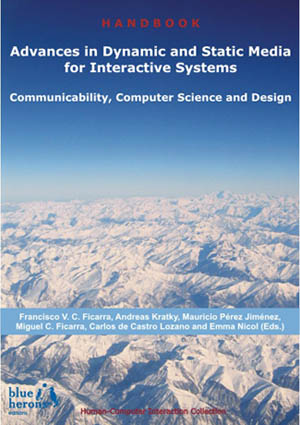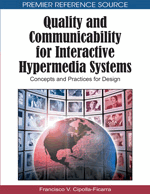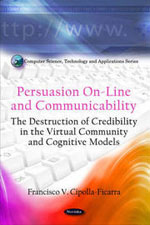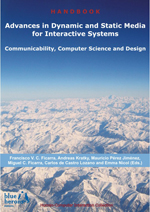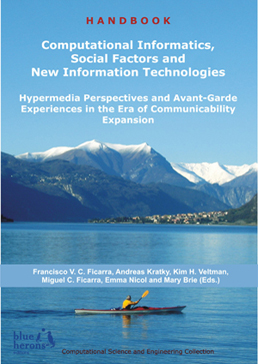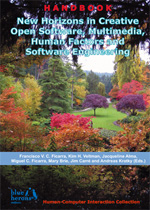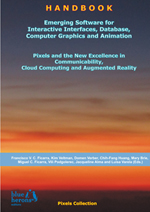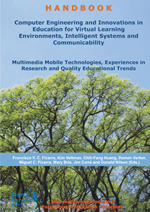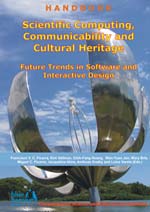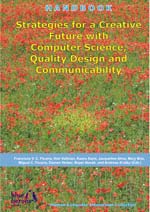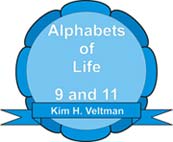Advances in Dynamic and Static Media for Interactive Systems: Communicability, Computer Science and Design
:: Human-Computer Interaction Collection ::
:: Revised Selected Chapters ::
Main Editor: Francisco V. C. Ficarra
Co-editors: Andreas Kratky (Los Angeles, USA), Mauricio Pérez Jiménez (La Laguna, Spain), Miguel C. Ficarra (Italy and Spain), Carlos de Castro Lozano (Córdoba, Spain) and Emma Nicol (Glasgow, UK)
Editorial Assistant: Mary Brie (La Valletta, Malta)
Book Details
• ISBN: 978-88-96471-08-1 :: DOI: 10.978.8896471/081
• Publisher: Blue Herons Editions
• Location: Italy (Bg)
• Subjects: HCI, Computer Science, Computer Graphics, 3D Model, Programming
• Subjects: Interactive Systems, Hypermedia, Graphic Design, Collaborative Environments
• Subjects: Communicability, Usability, Users, e-Commerce, e-Inclusion, eco-Tourism
• Subjects: Interface, Human Factors, Software Quality, Education, Entertainment
• Subjects: Ubiquitous Computing, Screen Reader, Verbal Protocol Analysis, Assessment
• Subjects: Robotics, Autonomatronics, Photography, Semiotics, Typography, iTV, ICTs
• Copyright: 2011
• Collection: Human-Computer Interaction
• Series volume: I
• Publication date: April, 2011
• Binding: Paperback
• Grade level: General
• Language: English
• Illustrations: Yes
• Colour: Yes
• Pages: 205
• Dimensions: 11.41x8.26x0.4 in. 1.21 lbs. :: 290x210x13 mm. 550 gr.
Preface
Hear, mortals, the sacred cry: “Freedom! Freedom! Freedom!”
Hear the noise of broken chains, see the noble Equality enthroned.
Alejandro Vicente López y Planes (1785 - 1856)
In less than half a century, the human being has switched from the access to the data stored in analogue support to millions of digital data which can hardly be read in the span of a whole lifetime.
Now data can be defined as that information which has been processed (or not) and which has been stored in a database. In a multimedia/hypermedia system the data are images, texts and sounds. Some of these three types of data may include or not the temporal component. The temporal component allows one to differentiate between the static and passive data and the dynamic and active data. The static data are those in which the temporal component is not present and do not need a synchronization among the data. In contrast, in the dynamic data the temporal variable is present. These dynamic and static data need a communication channel so that the user interacts with the system. The communication channels of interactive systems are known as ‘media’.
The data that are sent or received through the communication channels of a multimedia system allow to divide the channels into “static media” or “dynamic media”. Some examples of static media are the texts, the non-animated images, the maps, the graphics, etc. Whereas some examples of the dynamic media are the computer animation, the video and the sound. The difference between static and dynamic media lies in the presence or absence of the temporal variable in the presentation of the data.
In the dynamic and static media of the interactive systems of the 20th century were implemented and boosted the basic notions of the hypertext and the new way of structuring the contents, resorting to the nodes, links, indexes, etc. and a set of quality attributes. These quality attributes were first aimed at usability for an interactive system (1990) and later on to their communicability.
Since 1990 design has focused on the user of the potential hypertextual systems, multimedia and hypermedia. Currently the new horizons concentrate on the hardware and the interactive devices of small dimension which come to the hand of the user or may even be implanted inside the human body. For instance, some biotechnological prosthesis for the audiovisual communication of people with physical disabilities, such as eyesight or speech, for instance, to mention two examples.
In the evolution of the communication among humans it can be seen that there has always been an increase of quality in the communicative process. The technological breakthroughs of the 20th century have already made apparent the possibility of creating a global village, thanks to the social communication media which have used the written word, the cinema, the radio, television and computers. Nowadays these principles are to be spread to each of the inhabitants of the planet.
As it can be seen in the evolution of the computers, the software has always lagged behind the hardware. Microcomputing joined to telecommunications is generating at a dazzling speed new paradigms in social communication through the computers. However, the interactive design is still governed by the static communication models, especially with text. In the current creative process of contents for interactive communication with those computers, for instance, the computer animations, an educational video, a radial publicity, etc. usually starts with pencil and paper. That is, in the new millennium with the new information and communication techniques, the human being constantly returns to the early stages of writing. It is there where the wit and creativity of the fundamental structures of a new content must draw powerfully the attention to millions of potential users in the least possible time, and different cultures and mindsets. This is why these works must gather a minimal triad of quality attributes in the contents, such as are originality, simplicity and universality.
In the next pages is presented a selection of scientific works which allows one to have a first view of 360 in the avant-garde of the dynamic and static means of the interactive systems from the perspective of communicability, interactive design and computer science. These works depict a variegated state of the art and next trends, related to the dynamic and static media that we find in the current and future interactive systems on-line and off-line without forgetting their origins. Some of the chapters that make up the current handbook have been orally presented by their authors in the following international conference and workshop ADNTIIC 2010 (Advances in New Technologies, Interactive Interfaces and Communicability: Design, E-commerce, E-learning, E-health, E-tourism, Web 2.0 and Web 3.0), in Córdoba, Argentina and HCITOCH 2010 (Human-Computer Interaction, Tourism and Cultural Heritage: Strategies for a Creative Future with Computer Science, Quality Design and Communicability) in Brescello (Emilia-Romagna) Italy. These works have been expanded and reviewed again to be incorporated to the other chapters.
Finally a part of the title of the current book where we have a first compilation of avant-garde scientific works, refers to a pioneer subject in the Spanish state (static and dynamic media in the multimedia systems) in the first university lab of human-computer interaction of the Mediterranean coast (1997). A lab that did not count on any kind of financial or economic subventions or external pressures in the direction of the subjects to be investigated or developed. Consequently, the works made inside the lab and from that subject, for instance, had a total freedom since they were not tied to any commercial or political link out of college, for instance. The same has happened with the chapters of the current handbok. Many of them represent the continuity and the deepening of subjects that were treated in the first lab of human-computer interaction, away from the public and private subventions, and also away from the pressure groups that might impair the honest and modest development of the formal and factual sciences. Next a short summary of each one of them:
In the work “Lecture Notes on AutonomatronicsTM: Simply, Enabling Audio-Animatronics to be Independently Responsive and Reactive to External Stimuli” presented by Alfredo Medina Ayala we have the entertainment robots. In this research and project, the authors briefly discuss some background of automated robots and define some terms that help describe methodologies and concepts for autonomous shows within a flexible narrative. Besides, they assert by using some basic rules and concept that entertainers applied during a show, applies to autonomous interactive shows as well (we can see two samples: Otto and Gladys). Finally, they assert that it is uniquely important in the study of autonomous for theme park and location base entertainment.
In the research “ASTOR: Towards a Solution for the Administration of Conflicts in AspectJ”, the authors Sandra Casas, Claudia Marcos, Verónica Vanoli, Héctor Reinaga and Claudio Saldivia present a novel tool called “ASTOR”, which has mechanisms and strategies to improve the treatment of conflicts in Aspect). A state of the art of the conflicts and the problems of Aspect-Oriented Software Development (AOSD) is presented with the purpose of stressing the main qualities of the new tool. The research work is constantly accompanied with an important and accurate choice of examples. The purpose is to make easier to the reader the understanding of the novel tool. Also the authors analyze the conflicts resolution and thoroughly describe the details for an easy implementation of “ASTOR”. Lastly, there is a summary of the activities carried out and impending lines of R+D by the research team.
In “A Trip to Rome: Physical Replicas of Historical Objects Created in a Fully Automated Way from Photos” the author Luigi Barazzetti leads us into a new methodology to transform 2D photographs into 3D replicas. In this way he suggests the possibility the tourists have to turn those pictures of sculptures, details of façades, etc., which have been made with simple picture cameras including those obtained with multimedia phones, in real objects in 3D. A detailed description of the advantages of the presented methodology allows the reader to better understand the importance of the proposed methodology. In the chapter can be seen interesting real examples of a trip made in Rome by the author.
Oriol Camacho Díaz introduces us in his long work titled “Original Creative Process of a Graphic Catalogue for Signalling: Typography, Arrow and Pictograph” in the world the formal expression of the alphabet enlarges its visual values beyond an exclusive interest on a geometric clarity. It probes masterfully into an endless array of variables of design, related to the theoretical and practical aspects for ecotourism. In this regard he proposes several real examples from the Canary Islands, where it can be seen accurately the notions related to signalling, graphic design, photographs and typography, for instance. The conclusions and implications of the developed work allow us to point out new roads for future investigations in the context of graphic design applied to nature.
In the chapter, “Allegorical Interfaces: A Literary Approach to Interface Design for Digital Reading”, its author Andreas Kratky compares the previous digital revolutions of the music, film and publishing industries and attempts a prognosis of coming changes in the way we will work with digital texts. Besides, in order to understand the emerging transformation of the reading process through digital technologies better, it is helpful to firstly analyze the aspects of the two previous transformations that formed the digital music revolution and – in a slightly different form – the digital film revolution. Secondly it is necessary to compare the current situation with the earlier developments in the area of digital text distribution. As a conclusion a new notion of interface design for the emerging reading ecology is proposed and exemplified with the analysis of two interactive literary applications.
The authors Leda Beatriz Digión and Mabel Sosa of the chapter “Interface Quality Aspects Based on Learning Styles and Collaborative Tasks” present a model of early evaluation of the usability for e-learning, starting from the analysis of a personalized learner. Said learner is proposed to work in a collaborative space and included in a formal work team. The goal of the model is to generate the new attribute “learner’s framework” that together with the attribute “motivation to learn” enhances jointly the evaluation of usability. The reader will find among the pages a careful description of the main concepts, the techniques and the goals targeted in the generation of the model.
Maria Claudia Buzzi, Marina Buzzi, Barbara Leporini, and Caterina Senette are the authors of the chapter “Electronic Commerce: A Great Opportunity for the Blind”. In this chapter they present characteristics of e-Commerce, focusing on opportunities and problems for people with disabilities. Next, they report the results of an electronic survey carried out with 22 blind and 22 sighted users in order to understand the difficulties and obstacles they experience when shopping on-line, soliciting their expectations and suggestions for making the interaction simpler and more satisfying. Besides, they analyze the interaction with one of the most popular eCommerce web sites (eBay) simulating different user’s skills from different visually-impaired people.
In the work presented by Graciela S. Cruzado, Daniel A. Giulianelli, Rocío A. Rodríguez, Pablo M. Vera, Artemisa Trigueros, and Edgardo J. Moreno under the title “Analyzing, Measuring and Reducing the Digital Divide”, we have a detailed heuristic analysis of the division of the population in the face of the new technologies and the different educational alternatives to fill in that gap. The description of the e-inclusion speeds up the understanding of the main and secondary goals of the text. In it is presented a set of techniques to study the reality of the inhabitants of an area of the Spanish city of Granada in regard to the new technologies. The results are presented in the shape of graphics. Starting from these, a series of strategies and solutions have been established to the problem stated at the beginning of the research and the lessons learned while doing the work.
In the research “Context-dependent Notification Management for Awareness Support in Collaborative Environments”, the authors are Liliana Ardissono and Gianni Bosio. The chapter describes an interesant framework: the COntext depeNdent awaReness informAtion Delivery (CONRAD). They propose an awareness support tool, which enables the holistic management of awareness information across services, plus a personalized reception of information, reflecting the user’s interests. This tool implements a mediation layer between the user and the business services; it manages a unified view of the user’s workspaces, abstracting from the application-oriented views offered by individual business services.
Mauricio Pérez Jiménez presents in his work titled “Reviews on Photographic Representation” an analysis aimed at one of the static means per excellence, photography, and the main aspects that must be considered by photographers for the interactive systems. He carries out a detailed study from the theoretical-technical point of view down to the manipulation techniques. Finally, the author presents the case of photojournalism and the loss of the benchmark.
The authors Özkan Kiliç, Bilge Say and Onur Demirörs propose in their chapter “An Experimental Study on the Cognitive Characteristics of Modeling Notations” an important study to investigate the diagrammatic reasoning and error finding strategies of modelling representations. Besides, experiments were performed on a notation-familiar group with degrees in computer science related fields and a domain-familiar group with experience in simulated systems. In them they make apparent the importance of the use of eye movement and verbal protocols together with performance data underlines the error finding and reasoning mechanisms of the two different groups. A series of experiments have been carried out and the reached results are presented as the future lines of research.
The authors Francisco J. Burón, Carlos de Castro, Enrique García, José M. Rámirez, Beatriz Sainz, and Konstantinos Chorianopoulos of the chapter “New Approaches on iTV: Usability and Mobility Issues” present the wide adoption of small and powerful mobile computers, such as smart phones and tablets, has raised the opportunity to employ them in multi-user and multi-device interactive television scenarios. In particular, the partnership between a personal device and a shared one provides two possible output screens. Then, one significant research issue is to balance the visual interface between two devices with advanced output abilities. Besides, they present an architecture and a prototype that lets people transfer instantaneously the video they are watching between web devices. Finally, they demonstrate the flexibility of the proposed architecture in a prototype that employs the Youtube API and that facilitates seamless session mobility in a ubiquitous TV scenario.
In the chapter, “Usability Engineering Versus Social Sciences: An Analysis of the Main Mistakes” its author presents one of the most important deviations between the formal and factual sciences, through the usability applied to the dynamic and static means of the past, present and future. These deviations have had a negative significance for the social sciences because many of its methods and techniques that were used for decades were modified and presented as novel in the context of usability engineering, for instance. In the essay are explained the reasons why these deviations have taken place and the effects they have had on the design, development and maintenance of the interactive systems. A wide range of examples allows to confront quickly the consequences of these deviations in college education, the making of products, and service performance, in the framework of the new technologies of communication and information.
Francisco V. C. Ficarra
Bcn, Spain (April 2011)
Partial Content On-line (pdf format)
• Front Cover (here)
• Preface :: Acknowledgment (here)
• Chapters :: Final Remarks :: Author Index :: Keywords Index :: References ... (here)
• Back Cover (here)
Additonal Handook Info
• Only paper copy – no digital book on-line and/or off-line –
• Special Price € 95 (expedition cost not included) ... e-Commerce :: Info Form
Welcome to Blue Herons Editions!
The origin of this publishing project is to be found in the Canadian lands, where nature presents itself generous in many places of its wide geography. More...
Education, Communicability, Design, Computer Science, HCI, Computer Graphics and Computer Animation:
We focus on education and new technologies with 30 years long experience. More...
Literature and Journalism:
Intersection between universal literature, local new journalism (true stories), sociology and legal immunity. Two collections:
- Casoncelli Bergamaschi
It is a typical bergamasque dough filled with meat, similar to the raviolis. More...
- Menjar Blanc & Black
It is a typical sweet of the Catalan coast and the Balearic Islands. More...
Others New Releases:
See all others new releases in books, CD, DVD, etc. More ...
See all others new releases in books, CD, DVD, etc. More ...
Call for Papers: ADNTIIC 2015 :: HCITOCH 2015 :: SETECEC 2015 :: HIASCIT 2015 :: CCGIDIS 2015 :: IPCTIIC 2015 | HCITISI 2015 :: MSIVISM 2015

